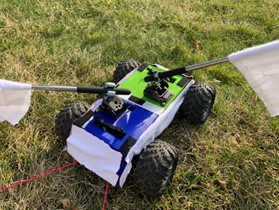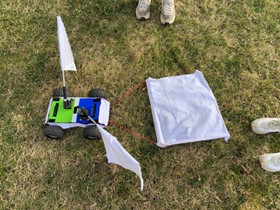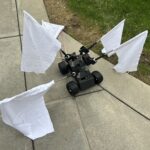Team Members




Supervisor

Customer


Problem Statement
The number of Tick-borne disease cases have become increasingly large in the past two decades, specifically affecting areas in Central America. However, in Costa Rica, there are minimal surveillance programs studying these vectors. To increase the amount of research, a tick-collection device that captures ticks automatically and decreases researcher risk of parasitism have become necessary. The criteria is as follows: versatile terrain locomotion (forest floors, grassy plains, and trail paths), roughly 30x30x30 cm, capture ticks for up to a hectare range (10,000 m2) during a 2-4 field session.
Background
We are in the process of developing a wheeled, mobile device with cloth attachments that will be able to capture ticks in Costa Rica in order to study ticks as vectors for disease. This device will allow researchers to collect ticks from a safe location and will require them to perform less physical labor. We also intend for this device to collect a large sample of ticks, since current collection methods do not yield enough ticks for their research. Our customers, Dr. Timothy Dye and Dr. Adriana Troyo, have requested an initial prototype near the start of March, which we have built and are preparing for shipment. This prototype consists of a remote controlled car with flannel attachments. Our progress up to this point has centered around selecting a car that is suitable for our needs and deciding what types of cloth attachments are likely to capture a significant sample of ticks. The remainder of this report will detail our efforts in constructing this prototype as well as why we have chosen our current design.
Customer Identification and Scenario
Our primary customers are researchers looking for large samples of ticks in order to study them as vector borne illnesses. Current methods for tick collection, such as cloth dragging and visual searches, are time consuming, labor intensive, and pose a risk for disease transmission. Normally, a small group of researchers would drag cloth, such as flannel, over vegetation or they would visually examine foliage for ticks and manually extract them with tweezers or scalpels. This requires researchers to commit to labor intensive days of surveying through tick infested areas. Further, these methods yield 0-5 ticks a day, which is insufficient for proper research on ticks as a vector for disease, according to our expert Dr. Adriana Troyo.
Our device will reduce the amount of incidental exposure for researchers by allowing them to control the car from a safe location. The device will be able to traverse tick infested areas in place of the researchers. Researchers should still take precautions such as dressing appropriately in case the device gets stuck or runs out of battery in the field and needs to be retrieved. In order to use the device, the batteries for the car itself must be charged and packed along with the normal laboratory equipment used to store the ticks once they are captured. The controlled battery should also be checked and packed. The batteries may need to be changed after 2 hours and will require researchers to remove the cover of the device. The device is approximately 3 kg and should be easily stored in the backseat or trunk of a vehicle.
Researchers can manipulate the angle and height of the cloth using the folding brackets on top of the car. The attachment that drags along the ground is designed to allow the researchers some room to reverse the device without becoming tangled. The cloth attachments on the rods and body of the car are detachable so that the cloth can be removed and stored once ticks are captured. The cloth trailing behind the car can also be removed by untying the string attached to the bumper. With this, each piece of fabric can be removed so that researchers can transport the ticks without needing to transport the whole device with the ticks. Then, according to our expert Dr. Troyo, the ticks will be removed from the cloth with scalpels and will be placed in conical tubes containing an RNA bath that is stored in a freezer. These components are not designed perfectly in the first prototype and are aspects we hope to refine and improve upon in the future. Ideally, this design concept will collect 100-200 ticks in a 2-4 hours field session.
Design Concept
Our customer expressed the need for our design to collect ticks along two heights: along the ground and within vegetation that can be up to approximately 30 cm above ground level. To accomplish this, we decided that our design would include a drag cloth that sweeps the ground behind the car as well as cloth attachments fixed to rods along the body of the car. The device is controlled by a remote control so that researchers can remain in a safe location whilst navigating the car through tick infested areas. We decided a car was the best mobile option for this project since ticks are collected on or near the ground, and remote controlled cars are easier to navigate and less disruptive to the native life than other devices, such as drones.
The novel cloth used to collect ticks is flannel, so we incorporated this fabric into our design as well. Since the rod attachments would be sweeping through foliage, there was a need for them to be able to whip back into place. To account for this, our initial prototype included torsion springs attached to the 3D-printed case of the car. When performing our field testing, the springs were too strong for our purposes, so in our second iteration, we decided to use fiberglass poles instead. The 3D-printed case was made to protect the car from moisture as well as provide a place to attach the rods. The case is attached to the car by Velcro straps so that it can be easily removed when the battery of the car needs to be changed.
Initially, we used teacher pointers as our rods, and these were attached to the car’s case by microphone stands. During our field testing, the microphone stands occasionally became loose and the rods did not have enough flexibility when passing through dense vegetation. To resolve these issues, we used pieces of the microphone stands along with a 3D printed holder for the new fiberglass rods that replaced the teacher pointers. With these modifications, the rods should more easily navigate dense foliage and should not hinder the car’s movement as the spring and teacher points did during the first iteration.
The flannel pieces that were attached to the rods were sewn to slide onto the rods and be easily removed. From each of the four rods, there was a piece of flannel that hung like a flag so that they could sweep through the vegetation. The flags were designed to be removed by sliding them off of the rods so that tick-infested pieces of flannel could be removed in a controlled and safe manner. The flannel is also able to be cleaned in between trials to get rid of excess debris that is caught. Below is a schematic drawing for our first prototype, excluding the cloth component that drags behind the device:
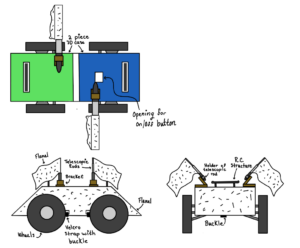
Our design concept has greatly depended on an iterative testing process and modifications were made as we performed physical trials, both in Rochester and in Costa Rica.
Prototype Process
Our initial prototype consisted of an RC car as the base, a 3-D printed durable casing to surround the chassis of the car, and 2 flannel pole attachments. The casing had to be printed using two different printers due to size constraints. They were designed to fit together with grooves, which was then glued and taped for reinforcement. The casing was designed with a few holes along the top. Two of the holes were for the bumpers to protrude out. The 3rd was for easy access to the power button. Velcro strapped buckles were used to secure the casing on the chassis. Flannel sheets were cut out and attached with Velcro to the casing. This was done to maximize the surface area of the flannel in contact with the environment. Holes were then drilled into the casing to apply the hinges which would hold the flannel attachments. Screws and nuts were found to secure the telescopic rod attachment points.
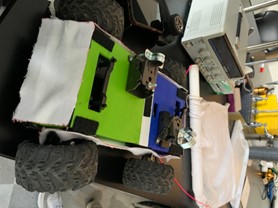
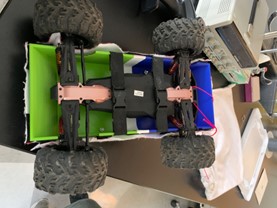
The flags were made for dragging along the side of the device, and a drag cloth was attached via string to the back bumper. Initially, only a flannel sheet was used. After field testing was completed in a grassy field, it was determined that it would need some structural integrity. A PVC pipe and wooden chopsticks were secured in the fabric using staples. Further field testing revealed that we needed to add more weight to the flannel to keep it propped up and the method of attachment would need to be upgraded.
The cloth attachments directly attached to the 3-D printed case were deemed to be unnecessary, and thus, removed. To increase contact surface area, two more flag attachments were added to the top of the case (4 in total). The mode of attachment for these flags was also altered. We 3-D printed a casing for the telescopic rod handles, which was then directly inserted into microphone stands. The microphone stands were then attached to springs, which were then directly attached to a new 3-D printed case. The microphone stands secure the telescopic rods well, while allowing a wide range of angle alteration to reach different types of shrubbery. The springs were intended to allow give without breaking when passing by flora then returning to the original position. The new 3-D printed case was designed with arches which gave it slightly more lift, where we were then able to comfortably fit a larger battery.
Feedback & Results of Field Tests in Costa Rica
Testing was performed at two field sites in Costa Rica April 15-19 with Dr. Troyo. The first site was in San Rafael de Vara Blanca, Heredia where there was three paths. This site had very dense vegetation and indirect sunlight. This site contained a specific tick that only lives 1500 km above sea level. The ticks at this site were “sit and wait,” which are traditionally less likely to be collected with flannel dragging.
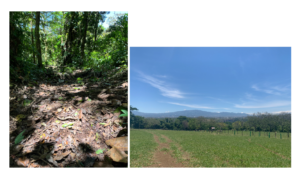
The second site was in El Rodeo, Ciudad Colón and was large horse pastures with tall grass. This site was much warmed and had direct sunlight. This site also had a different species of ticks that is aggressive towards animals. These ticks are commonly collected by tick dragging.
At each site, there were multiple fields or paths, so one side was performed with the vehicle, the other using novel techniques such as manual flannel dragging and visual inspection. This collection was done for about 30 minutes then, we swapped sides/trails and performed our collection again for about 30 minutes. After each session each cloth was closely examined for ticks of three life stages: larvae, nymphs, and adults. Our collection results are summarized below:
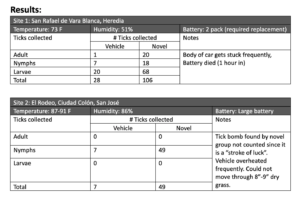
Three researchers made up the team performing the novel research and one person controlled our device. With this in mind, our device performed about as well as one researcher using the novel technique. Our device was greatly limited by its height off of the ground and became easily stuck on foliage. The initial rods we had also hindered the cars movement. We also found that the cloth dragging behind the car was not effective for capturing ticks, so this component was detached. Despite our device’s limitations during field testing, Dr. Troyo did note that the device was still useful for reaching more remote locations are researchers would not enter themselves. Regardless of the significant mobility issues we faced, the flannel flags on the body of the car were still effective in capturing ticks from the foliage. We have also already made modifications to the rods so that they do not interfere with the cars movement. With improvements to the car itself, our device would be a useful tool for tick collection in Costa Rica. The device greatly reduced the amount of labor involved with traditional tick collection methods and allows the researchers to remain in a safe location while the device can navigate through tick-infested areas.
Overall, Dr. Troyo and Dr. Dye believe our design can be useful for tick collection in Costa Rica, but we believe significant modifications to the body of the device need to be made before the device can be used in place of traditional methods.
Future Directions
Our device can be improved in the future by using a remote controlled car that is higher off of the ground. During our field testing in Costa Rica, the foliage often extended between 0-15+ cm off of the ground. This greatly hindered the ability of the device to move and perform its collection. Likewise, a different covering or a cooling system for the motor may need to be considered since the device overheated in one of the field sites that was over 32.2°C (90°F). We have already modified the attachments based on our testing, so future plans would include modifying the height of the car and implementing a system to ensure that the motor can withstand the heat under prolonged use.
Acknowledgements
We would like to extend our gratitude to the following people for their continued support, expertise, and guidance:
- Dr. Adriana Troyo
- Dr. Tim Dye
- Dr. Scott Seidman
- Marty Gira

